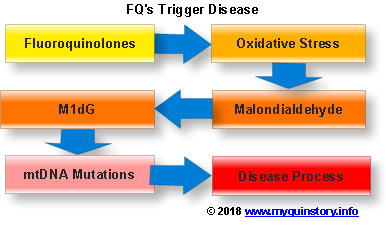Introduction
The fluoroquinolones (FQs) are metabolically invasive antibiotics that kill their targets effectively, both directly and indirectly. When something goes awry, and they indiscriminately target healthy human cells, they also damage both directly and indirectly.
By their very nature FQ’s do not need to remain in the body to do damage long term. In this brief article we will look at how they can cause mitochondrial disease or other disease processes by being an effective epigenetic trigger.
Background
Dr. Bruce H Cohen, one of the foremost experts on mitochondrial (mito) disease, when discussing mito cytopathy in adults states that mito disease can be inherited or acquired. The cause for mito disease can be genetic mutations, acquired somatic mutations, or exposure to toxins, which includes prescription medication 1.
Dr. Cohen, also writes, in a bulletin that discusses Myths and Facts About Mitochondrial Cytopathies titled “Not Your Mother’s Mitochondrial Disease,” that mito’s become poorly functional as a consequence of, amongst other things, toxin exposure. What exactly defines toxin exposure is very broad spectrum as pharmaceutical drugs can be considered toxic. He also states that mito mutations can become pathogenic because of a trigger, an epigenetic trigger 2. Let’s look at how the FQ’s can ‘pull the trigger’ on the disease process.
Misconceptions
Initially, let’s clear up some misconceptions. The first one is that mitochondrial diseases are maternally inherited. This is a myth that is based on old medical information. The truth is that most mito diseases are due to mutations in the nuclear DNA 2.
The second misconception is that if you develop mitochondrial disease/dysfunction later in life you were predestined to have mitochondrial disease due to flawed genetics. Again, this is incorrect. While it is true that a person can have a genetic predisposition to certain health traits or even diseases due to inherited disease gene variations, pharmaceuticals (toxins) can cause the genetic mutations that cause the disease process. To this day, this myth is perpetuated by many in the medical community and as a result they fail to see how the FQ’s can cause or initiate a mitochondrial pathology. Many doctors still see mito disease as being inherited from the mother and mainly affecting very sick children. By dismissing any other possibility, or probability, they throw the baby out with the bathwater.
predisposition to certain health traits or even diseases due to inherited disease gene variations, pharmaceuticals (toxins) can cause the genetic mutations that cause the disease process. To this day, this myth is perpetuated by many in the medical community and as a result they fail to see how the FQ’s can cause or initiate a mitochondrial pathology. Many doctors still see mito disease as being inherited from the mother and mainly affecting very sick children. By dismissing any other possibility, or probability, they throw the baby out with the bathwater.
Many years ago, I theorized that the fluoroquinolones (FQ’s) are an epigenetic trigger. Like a stack of dominoes falling over, or a snowball rolling down the hill, the FQ’s are the initiator, or in a nutshell, the substance that starts the ball rolling. In addition, not only do FQ’s start the process, they give it a good push to get the ball rolling so to speak.
Recent Discoveries
New discoveries have proven what we have suspected for some time about the triggering process. Recently Vanderbilt University School of Medicine researched both mitochondrial DNA’s (mtDNA) and nuclear DNA’s (nDNA) interaction with oxidative stress (ROS) 3. Keep in mind that certain levels of oxidative stress are required for cellular function. However, if you create an over-abundance of ROS in the wrong sort of way it can lead to a whole host of serious metabolic problems than range from the mild to lethal in their scope.
mitochondrial DNA’s (mtDNA) and nuclear DNA’s (nDNA) interaction with oxidative stress (ROS) 3. Keep in mind that certain levels of oxidative stress are required for cellular function. However, if you create an over-abundance of ROS in the wrong sort of way it can lead to a whole host of serious metabolic problems than range from the mild to lethal in their scope.
In the Vanderbilt study, a toxin produced by ROS known as M1dG was looked at. The Vanderbilt team compared levels of M1dG generated by interactions between mtDNA and nDNA and ROS. A very important finding was discovered. This finding was that the interaction between mtDNA and ROS generated 50 to 100 times more M1dG than the interaction between nDNA and the ROS.
Why is this important you might ask? Well, let me explain. Like most things, M1dG in small amounts plays an important role in mito regulation and metabolism. However, if you bombard M1dG with excess oxidative stress it can form an adduct in mito DNA that causes mutation and disease. Not that mutations in nDNA cannot cause problems, they can, but nDNA has more robust repair mechanisms that mtDNA. This makes mtDNA much more susceptible to oxidative damage. In other words, oxidative stress cause an M1dG adducts to form in the mtDNA, this in turn created a mutation and triggered that mutation to change the fate of the cells that lead to a disease process.
If that went past you too fast, let me reiterate. The researchers were able in induce a mitochondrial disease by increasing ROS which in turn produced a toxin which mutated mtDNA and caused a disease process. An epigenetic trigger. The researchers found out that M1dG poses a danger because it can trigger genetic mutations, changing the fate of cells.
Enter the FQ’s
The researchers at Vanderbilt were not looking at antibiotics as the ROS generating mechanism but instead just looking at the M1dG DNA interaction after ROS was generated. However, in light of this research I will briefly look at the FQ’s.
I remembered from the recesses of my mind that certain antibiotics could also increase M1dG. Yep, you guessed it. The FQ’s induce toxic metabolic perturbations that lead to cellular damage 4. One way they do this by an enormous oxidative stress 5 which can produce malondialdehyde and in turn M1dG 5 6. M1dG then has the propensity to mutate mtDNA which leads to a pathogenic process. This can lead to direct mitochondrial disease or create mutations that cause other pathogenic (disease) processes that are driven by the mitochondria.

Adducts
A quick note about adducts. A few years back there was a theory sweeping the FQ community that FQAD was solely caused by nDNA adducts. Adducts happen when a molecule breaks down and part of that molecule, a metabolite, adducts or connects itself to the DNA. Adducts can start pathogenic processes such as cancer and the like. Adduction is very complex, so I will keep this synopsis brief.
The M1dg adduct is not a direct metabolite of the FQ molecule. This nasty little mtDNA adduct is produced by ROS. We have learned that the structure of the FQ molecule itself prevents direct adductions from forming ‘consistently’ across a given population. One reason is because of the tremendous variables involved in the metabolization of the FQ molecule. Dr. Noble, geneticist, oncologist, professor and researcher of pharmaceutical toxicity at the Univ. of Rochester, also holds to this opinion as well. Direct FQ adducts are randomly possible; however, this is also the case with many substances both natural and man-made. The FQ’s do their dirty work via multiple avenues both direct and indirect, which explains the wide variety of pathologies that are seen.
Scary Dangerous
Drug’s that can mutate DNA and create a disease process are scary. Why? Because they start the ball rolling on a pathology that can become chronic or lethal often appearing later down the road. After all, who would suspect the FQ’s as causing Alzheimer’s, Parkinson’s and other serious neurodegenerative diseases. The FDA implied exactly that very thing during their internal FDA pharmacovigilance review memo dated April 17, 2013 on the Fluoroquinolones, issued by the Food and Drug Administration’s Center for Drug Evaluation and Research, Office of Surveillance and Epidemiology. They point out that the method of damage caused by the FQ’s is mitochondrial toxicity which is also the underlying mechanism in neurodegenerative diseases such as Parkinson’s, Alzheimer’s, and ALS 7.
down the road. After all, who would suspect the FQ’s as causing Alzheimer’s, Parkinson’s and other serious neurodegenerative diseases. The FDA implied exactly that very thing during their internal FDA pharmacovigilance review memo dated April 17, 2013 on the Fluoroquinolones, issued by the Food and Drug Administration’s Center for Drug Evaluation and Research, Office of Surveillance and Epidemiology. They point out that the method of damage caused by the FQ’s is mitochondrial toxicity which is also the underlying mechanism in neurodegenerative diseases such as Parkinson’s, Alzheimer’s, and ALS 7.
Remember, no one knows whether they are susceptible to an adverse event or not. It is just like playing Russian roulette. Just because someone has supposedly had a safe course of FQ’s, the next time they might not be so lucky. Also, how do they know they were not damaged the first time around since genetic damage may not appear for quite some time after ingestion?
Conclusion
In the paper “Oxidative Stress Induced by Fluoroquinolones on Treatment for Complicated Urinary Tract Infections in Indian Patients” from 2011, the authors conclude “There was a considerable increase in lipid peroxide levels indicating an enormous oxidative stress. Caution to be taken for patients especially on Ciprofloxacin and Levofloxacin therapy.” This paper, like many others, sounds alarms that needs to be taken seriously.
The FQ are dangerous in their propensity to damage and never should be used haphazardly or without informed consent. This brief article outlines one way, albeit a very dangerous one, in which the FQ’s can trigger disease but please keep in mind that this is not the only way they can do their damage. I have already shown that FQ’s are chemotherapeutic (anti-tumor) pharmaceuticals that destroy via Topoisomerase interference just like chemotherapy (you can watch the short video here). There are many other ways in which they can interact with cells in a harmful fashion, from DNA to cellular substructures. In an upcoming article I will discuss what happens when this chemotherapeutic (anti-tumor) family of antibiotics interferes with Topoisomerase 2 (TOPO 2)in a novel way that I have never outlined before, causing TOPO2 to malfunction leading to cell death and senescence. Can you say premature aging?







Hi,
This has been the best site yet for getting the information I need and it is brought down to an understanding level. I so appreciate all the time and energy you are putting into keeping us specifically informed. I was floxed July 9, 2018 from levofloxacin and now I have to take it one moment at a time one day at a time because there is so much unknown of how my body will perform or not. Thanks so much. Cindy in Maine
Thank you, good luck with your search, and I hope that you find healing along the way.
Thank you for this information! I was on Cipro in January 2018; and still have daily side effects from this medication. If only I had known before taking it. I am researching what I can and would love to join any groups / organizations / anything that is working to get the information out there, or working to push for the FDA to pull these off the market!
Hi.
I think it’s all an inmune response in nature. I did what any person did. When i took moxifloxacin i was taking simultaneouslly minocin and biaxin… i continued taking minocin and biaxin and my symptoms worsened… until i stopped two meds and switched to others… doxy, azithro etc… but another day i tried again minocin… and think what happen… all the floxin symptoms returned like if i was taking a moxifloxacin pill… It’s autoinmune in nature… i only took one pill of levaquin. It’s not enough to cause mito damage… Maybe if you took more than 15/20 pills mito damage could happen but not with one pill… and symptoms returning when taking something that i took the same day.
Thank you 🙂
Oriol.
you rock. my brain hurts reading this but it is not your fault this stuff is so complex. Between definitions on line and re reading sometimes, I am getting a grip on the process. Thank you so much. I only found you through doing a book review search. My best info on floxie has been found by accident,
Susan, thank you for your kind words.
Cipro 2010 Huge ruptured tendon(unaware of the connection.
1 Cipro IV and 10 500 mg capsules given on cruise ship in the Adriatic Sept 2017: 11th day was extremely sick, struggled on many levels, feet and calves destroyed but improved at months 9 and relapsed and again improved in month 15, relapesed now. Changhed to no CARB little sugar diet, and fasting as well as 10 supplements. Seing improvement, especially with calorie restriction.
I have been taking Cipro 750 for the past 18 years for reoccurring cellulitis due to a GR III open tib/fib fx. The first for years I took it daily. Now I take it ass needed .This is usually 3x per year for an average of 42 days per treatment. No other antibiotic has worked for me , except Vancomycin, I have suffered so many of the symptoms but never knew what was the cause. I have been tested for so many different disorders but nothing ever panned out.
One day I was praying about it and had the thought that Cipro is making me sick. I googled Cipro poisoning and discovered this whole world of FQAD. I approached my doctor with this and he researched it. We have concurred that I have an acute case of this. Each time I take it my symptoms worsen and continue for weeks after I stop taking it but I never return to where I was either. Currently I can hardly walk because my legs are so stiff. and I stopped taking it 2 weeks ago. I cannot sleep either. I could go on and on with all the symptoms that I exhibit.
Paul, I am sorry that you are suffering from the FQ’s. I hope and pray that you can find healing for your situation.
Hello from Germany! I am 37 years old and took only 2 tablets cipro 500 and since 2 months i cant walk and have pain in muscles and joints. My complete nerve system is terribel condition. In Germany there is not even a warning about FQ and Cipro is the most prescripted antibiotic. Ten thousands of people suffer and doctors blaim all as menthally sick and dont believe that this comes from FQ. Your site is fantastic and the best reaserch site in the internet worldwide.I have great respect for the amazing work you did as it gives a lot of information which NO doctor in Germany ever heard about.Thank you and god bless you! Best wishes from your friends in Germany!